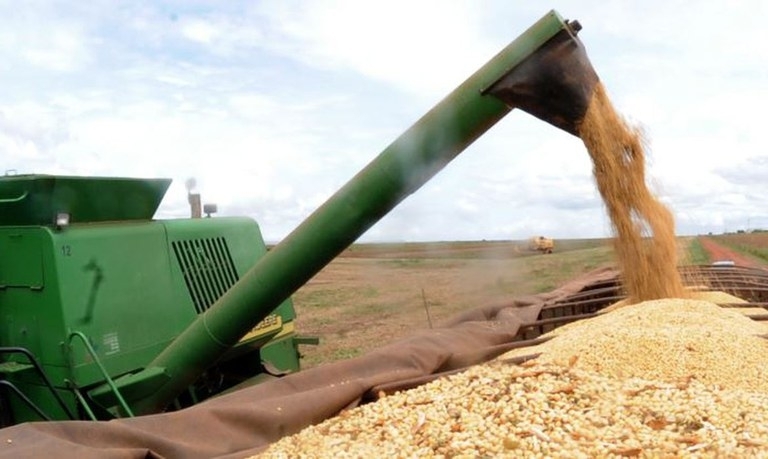


These factors combined have worsened the severe drought conditions in the transition zone between the eastern Amazon and the Brazilian savanna, where the main soybean-producing region (MaToPiBa) is located. The researchers who detected the trend warn that crop yields could fall (photo: file/Agência Brasil)
Published on 02/28/2022
By Elton Alisson | Agência FAPESP – Deforestation for agribusiness expansion in Brazil, in conjunction with climate change, has worsened the already severe drought suffered in the last decade by the transition zone between the eastern Amazon and the Cerrado, the vast tropical savanna ecoregion in central and western Brazil.
This combination of trends endangers the stability of the biomes concerned and constitutes a risk to food production in the region known as MaToPiBa, a portmanteau of Maranhão, Tocantins, Piauí and Bahia, parts of which form Brazil’s agricultural frontier. The region accounts for almost 12% of the nation’s soybean crop, for example.
The warning comes from an article published in the journal Scientific Reports by a group of scientists affiliated with research institutions in Brazil, Spain and France.
The article reports the findings of a study conducted by researchers at the National Disaster Surveillance and Early Warning Center (CEMADEN) and supported by FAPESP via a Thematic Project. The research was also funded by the National Institute of Science and Technology for Climate Change (INCT-MC), one of several INCTs funded by FAPESP in partnership with the National Council for Scientific and Technological Development (CNPq) in the state of São Paulo.
“Current conditions already show that this transition zone between the Amazon and the Cerrado is suffering the impact of land-use change for agribusiness expansion, as well as the impact of climate change. These processes could become more intense in future, impacting the biomes and adversely affecting harvests in MaToPiBa, especially of soybeans,” José Marengo, CEMADEN’s head of research, principal investigator for INCT-MC, and first author of the article, told Agência FAPESP.
The researchers used meteorological and satellite data to analyze changes in hydrology and weather in tropical South America in the last four decades. They identified regions that have undergone long-term warming or drought since 1981 by scrutinizing spatial patterns for a range of radioactive, atmospheric and hydrological variables.
In particular, they found that average temperatures in the Amazon-Cerrado transition zone rise significantly as the dry season gives way to the wet season (July-October), delaying the arrival of seasonal rainfall and worsening the already severe drought conditions in the last decade.
“Our results evidence a rise in temperatures, a growing vapor pressure deficit, increasingly frequent dry days, and a decrease in precipitation, humidity, and evaporation,” Marengo said. “They also point to a delay in the onset of the wet season, heightening the risk of fire during the dry-to-wet season transition.”
Croplands more than doubled in area from 1.2 million hectares to 2.5 million hectares between 2003 and 2013, with 74% of new croplands replacing previously intact Cerrado vegetation.
“The study provides observational evidence of the growing climate pressure in this area, which is important to global food security, and the need to reconcile agricultural expansion with protection of natural tropical biomes,” Marengo said.
Adaptation plan
Drought in the Amazon and the adjacent Cerrado is usually associated with El Niño events and/or warmer than usual sea surface temperatures in the tropical northern Atlantic, Marengo explained.
Warmer ocean temperatures favor the occurrence of warmer land temperatures, with anomalous regional water deficits and intense fire seasons, all of which threaten to limit soybean output in the MaToPiBa region.
Soybean yields fell during the 2015-16 El Niño, when output totaled 95.4 million metric tons, compared to 96.2 million mt in 2014-15.
“In future, events like the 2015-16 El Niño could be more intense, and it’s important to start implementing adaptation measures to mitigate the impact of climate change in the region, including a reduction in deforestation in the Amazon and land-use change in the MaToPiBa region. If nothing is done, agricultural production will fall because it depends closely on the climate,” Marengo said.
Researchers at the National Space Research Institute (INPE) in Brazil and the Universities of Valencia in Spain and Grenoble in France also took part in the study.
The article “Increased climate pressure on the agricultural frontier in the Eastern Amazonia-Cerrado transition zone” (doi: 10.1038/s41598-021-04241-4) by José A. Marengo, Juan C. Jimenez, Jhan-Carlo Espinoza, Ana Paula Cunha and Luiz E. O. Aragão is at: www.nature.com/articles/s41598-021-04241-4.
Source: https://agencia.fapesp.br/38053